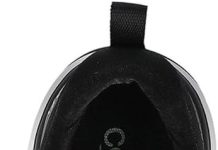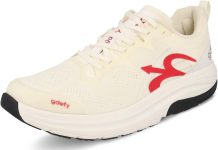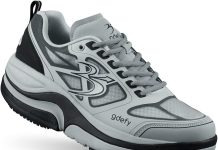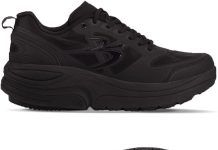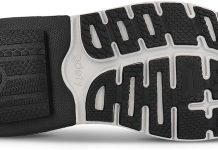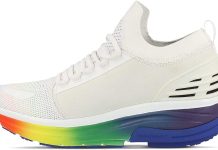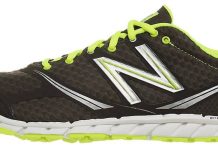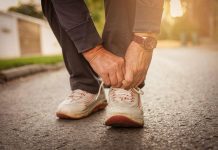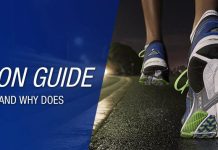The foot’s normal biomechanics absorb and direct the occurring throughout the gait, whereas the foot is flexible (pronation) and rigid (supination) during different phases of the gait cycle.
As the foot is loaded, eversion of the subtalar joint, dorsiflexion of the ankle, and forefoot abduction occur.
Pronation should not occur past the latter stages of midstance, as the regular foot should then supinate in preparation for toe-off.
Are you a pronator or a supinator?
So the question is, Do I overpronate or supinate?
Pronation
Pronation is a natural motion of your foot during walking and running. Your feet, while walking, can show stages of neutral pronation overpronation or supination – under pronation.
The stress of overpronation or supination can cause pain and injuries.
Shoes for foot conditions, motion control shoes, and insoles will help with overpronation, while flexible and cushioned shoes will be better for people with supination.
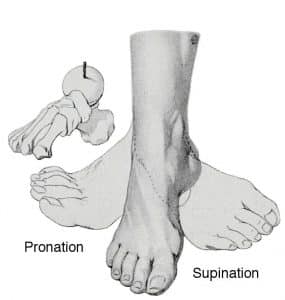
Overpronation
Overpronation is when ankles roll too far downward and inward, which you make.
Ankles continue to roll when the toes should be starting to push off the ground.
This movement’s result is pressure on the big and second toe, making all the effort of the push-off, and the foot twists more with each step you take.
Overpronation is common when people have flat feet, but not everybody has overpronation.
Pressure on the big and second toe strains them, making the foot unstable.
Excessive foot rotation can cause the tibia in the lower part of the leg to rotate, resulting in pain, shin splints, and knee pain.
Overpronation leads to excessive strain in the posterior area of the tibialis tendon, shin splints, and dysfunction in older adults.
Overpronation shoes with motion control designed soles and fixation insoles will correct foot movement in the shoe and get your overpronation under control.
Supination
Supination or underpronation is a foot condition when a rolling motion goes to the foot’s outer edge during walking.
The foot’s natural movement is to supinate while taking an off-toe moment from your stride as the heel goes first off the ground to provide leverage to help roll off toes. When in the supination stage, the foot does not pronate enough at the toe-off stage.
In this kind of movement, all the pressure is on the foot’s outer edge and the rest of the toes, adding an extra dose of foot stress.
People with high and rigid arches more often have supination because they don’t flatten enough during movement.
Underpronation or supination can cause ankle injuries, iliotibial band syndrome, Achilles tendonitis, or plantar fasciitis.
Supinator places extra pressure on the outer sections of the foot and stresses fractures on the large bones in the middle part of your foot connected to the two toes, the pinky toe, and the toe next to him.
When you have supination, your tiny toes do all the work in the push-off phase while walking or running.
Extra-layered cushioned shoes with flexible soles and support will help with foot supination and underpronation.
Diagnose your gait condition – Do I overpronate or supinate?
Shoe soles pattern
To answer “Do I overpronate or supinate,” Take your walking or running shoes and look at their soles. Overpronation will appear in more wear on parts on the inner side of the heel and forefoot.
Supination will be seen in more worn-off outside parts of the shoes.
The shoes’ tilt – take your walking or running shoes that you wear every day for a few months. Put your shoes on a flat surface, table, or floor, and have the heels facing you.
When the heel tilts inwards, and the heel’s inner part is more worn off, that is a sign of overpronation. If your shoes’ heels are tilted to the outer side, that is a sign of the foot’s supination condition.
Specification – shoes for overpronation – stable mild shoes with motion control or custom orthotics for severe conditions.
Specification – shoes for supination – neutral and flexible shoes with extra layered cushioning or custom orthotics for severe conditions.
Read Next – Shoes with the Best Motion Control for Walking and Running
Shoes for overpronators
Motion-control shoes will help correct the posture of your gait and the whole leg.
This type of shoe for foot condition has increased the medial support and has a much stiffer construction to guide the foot and put it into the pronation position.
Those shoes are heavier and more rigid than most neutral sports shoes.
Shoes for supinators
Neutral shoes are the best choice for people with a supination diagnosis. Extra cushioned shoes for supination can absorb more outside impacts on the leg than other shoes.
Flexible shoes are a perfect fit for the supination foot condition.
Those shoes will allow more significant movement and higher motion. Extra cushioning is part of the boots for the supinators.
Read Next – Running Shoes for Supination Condition Features
Conclusion – Do I overpronate or supinate?
Both overpronation and supinators can add an extra workout to the routine that will help with their overpronation or supination condition, depending on what they have. Supinators can add stretching to their routine.
Regular stretching will help alleviate tension that can cause pain in your foot, legs, and whole-body posture.
Overpronators can do the demi plie with the turnout from the hips, roll the feet while standing to the outside part of the feet and seated calf stretch, sit down and put your legs in front of you and have them flexed, hinge forward at the waist and reach out for your toes.
We hope that you have found your answer to the question, “Do I overpronate or supinate?”
Read Next – Best running shoes for neutral arches and supination
How To Tell If Your Feet are Pronated Or Supinated
What are Pronation and Supination?
Definition of pronation and supination
Pronation and supination are natural foot and ankle movements that occur during walking or running. Pronation refers to the foot’s inward roll, while supination involves the outward roll.
How does pronation and supination affect the body?
Pronation and supination are crucial in shock absorption and propulsion during gait. Improper pronation or supination can lead to issues such as plantar fasciitis, shin splints, and Achilles tendonitis.
Common signs of pronation and supination issues
Common signs of pronation issues include foot pain, wear on the inside of the shoe, and flat feet. On the other hand, supination issues may manifest as high arches, ankle sprains, and wear on the outside edge of the shoe.
How to Identify Overpronation and Underpronation
Visual cues for overpronation and underpronation
Overpronation can be identified by excessive inward rolling of the foot, while underpronation is characterized by insufficient inward roll and more weight on the outside of the foot.
Using insoles for overpronation and underpronation
Insoles or orthotics can help correct overpronation or underpronation by providing additional support and stability to the feet’s arches.
Importance of gait analysis in identifying pronation issues
Gait analysis is essential in determining the degree of pronation or supination during walking or running. It helps podiatrists recommend suitable footwear or orthotic solutions.
Effects of Pronation and Supination on Foot Health
The link between pronation and supination and standard foot problems
Pronation and supination abnormalities can lead to conditions like plantar fasciitis, bunions, and shin splints due to the altered biomechanics of the lower extremities.
Role of footwear in managing pronation and supination
Proper footwear with adequate arch support and cushioning is crucial in managing pronation and supination issues to maintain proper foot alignment and prevent injuries.
How orthotics can help with pronation and supination issues
Custom orthotic inserts can provide targeted support to address overpronation or underpronation, reducing foot strain and minimizing the risk of related injuries.
Seeking Professional Help for Pronation and Supination
When to consult a podiatrist for pronation and supination concerns
It is advisable to see a podiatrist when experiencing persistent foot pain, gait abnormalities, or recurring injuries related to pronation or supination.
Treatment options for severe pronation and supination cases
Severe cases of pronation or supination may require custom orthotics, physical therapy, or even surgery to correct alignment issues and relieve associated discomfort.
Importance of regular foot exams for monitoring pronation and supination
Regular foot exams can help track changes in pronation or supination patterns and allow for timely interventions to prevent the worsening of related conditions.
Preventive Measures and Lifestyle Changes for Pronation and Supination
Choosing appropriate running shoes for pronation and supination
Selecting running shoes with motion control for overpronation or cushioning for supination can help maintain proper foot alignment and reduce the risk of injuries.
Exercises to strengthen muscles affected by pronation and supination
Strengthening exercises targeting the foot, ankle, and lower leg muscles can improve stability and balance to prevent overpronation or underpronation-related issues.
How to prevent pronation and supination-related injuries
Proper warm-up routines, wearing appropriate footwear, and maintaining a healthy weight are critical preventive measures to mitigate the risk of pronation and supination-related injuries.
PUMA Women's Tazon 6 WN's fm Cross-Trainer Shoe, Black Silver/Beetroot Purple, 9.5 M US
$49.94 in stock
Plantar Fasciitis Feet Insoles Arch Supports Orthotics Inserts Relieve Flat Feet, High Arch, Foot Pain Mens 10-10 1/2 | Womens 12-12 1/2
Superfeet GREEN - High Arch Orthotic Support - Cut-To-Fit Shoe Insoles - Men 9.5-11 / Women 10.5-12
ASICS Women's Gel-Contend 6 Running Shoes, 8, Sheet Rock/Diva Pink
Powerstep Pinnacle Insoles - Shoe Inserts for Arch Support, Plantar Fasciitis, Pronation, Heel & Feet Pain Relief - Podiatrist-Recommended Orthotic Insoles for Women & Men (M 10-10.5, W 12)
$39.68 in stock
ASICS Men's Gel-Venture® 8 Running Shoe, 10.5, Sheet Rock/Electric Blue
PCSsole’s 3/4 Orthotics Shoe Insoles High Arch Supports Shoe Insoles for Plantar Fasciitis, Flat Feet, Over-Pronation, Relief Heel Spur Pain
$19.94 in stock














